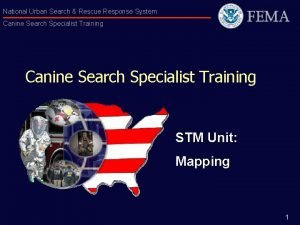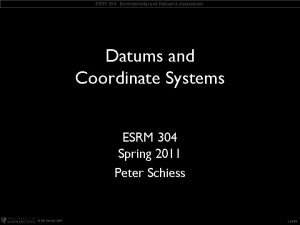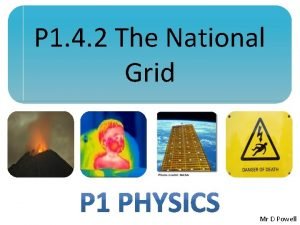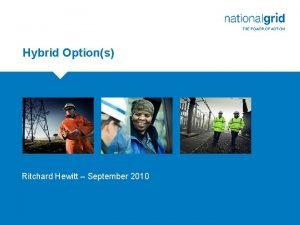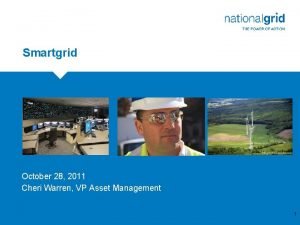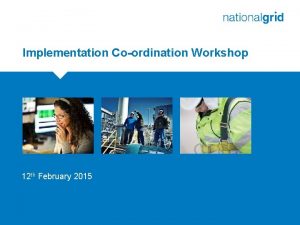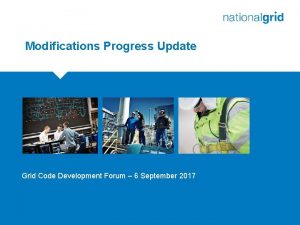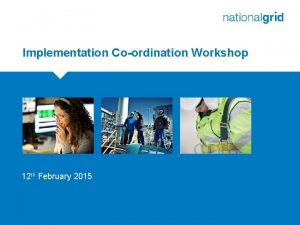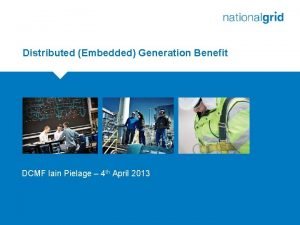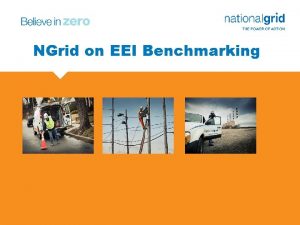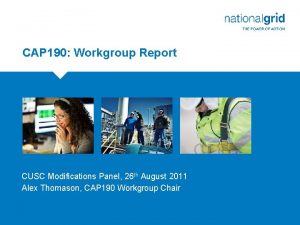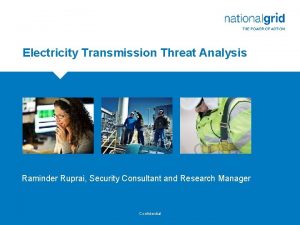National Grid Place your chosen image here The
















- Slides: 16

National Grid Place your chosen image here. The four corners must just cover the arrow tips. For covers, the three pictures should be the same size and in a straight line. Electricity Transmission Raminder Ruprai, Security Consultant and Research Manager Confidential

National Grid UK and US Electricity and Gas Transmission & Distribution 2

Key facts ¾ Employees, consumers and customers ¾ ~ 28, 000 employees 63% work in the US ¾ Distribute gas on behalf of shippers and suppliers to around 11 M consumers in the UK ¾ 4. 4 M electricity and 3. 4 M gas customers in the US ¾ Transmission: ¾ 9, 000 circuit miles of high-voltage overhead line and 420 miles of underground cable in the UK; ¾ 10, 000 miles of electricity transmission in the US ¾ 60 entry points and 200 supply points to distribution companies ¾ 337 UK and 680 US substations ¾ 4, 300 miles of high pressure pipeline, 106 off-take points for eight distribution networks ¾ 7 coastal terminals and 26 compressor stations ¾ Distribution: ¾ 82, 000 miles of pipeline covering ¼ of Britain and 32, 000 miles of main and distribution pipes in the US ¾ 122, 000 circuit miles of electricity distribution ¾ Generation ¾ 4, 150 MW of generation capacity in the US 3 Confidential - shared with CPNI at AMBER

Electricity – National Grid scope ¾ Electricity Transmission (UK & US) – green shaded area ¾ Electricity Distribution (US only) – blue shaded area ¾ Non Regulated Businesses – Generation (US) and Interconnectors (UK and US) 4

Electricity Transmission Grid ¾ The Electricity Transmission network or grid consists of the following components: ¾ Generators of electricity i. e. coal, gas, nuclear, solar, wind (etc. ) power stations ¾ Distributors of electricity i. e. those organisations that distribute electricity in a local/regional area ¾ The ‘highway’ of high-voltage (400, 270, 132 k. V) electrical transmission network that connects generators to the distributors ¾ The data highway that travels with the power lines, which provides data links between the control room, transmission substations and load areas (distributors) ¾ The Supervisory Control and Data Acquisition (SCADA) system that takes the data and controls the electrical transmission grid equipment through its links to all transmission substations ¾ The Electricity Balancing System which issues instructions (forecasts and real-time status) to the generators and distributors via dedicated communication lines.

Managing the Network I ¾ A country’s electricity transmission grid is essential for the well being of its citizens, economy and government, therefore resiliency and availability are necessary and key requirements. ¾ As a result, for each and every end user of electricity there a number of transmission lines that can be used to service them. This allows for lines and pylons (towers) to be maintained without any interruption in the supply of electricity. ¾ Managing the grid involves knowing which transmission lines are ¾ Operational, ¾ their maximum load capacity ¾ when they are due for maintenance work. ¾ With this information, the control centres can determine which transmissions lines to take out of action for maintenance and where and how much electricity load can be spread across the rest of the network.

Managing the Network II ¾ The UK Transmission Network includes over 200 transmission substations. ¾ The transmission substations throughout the country provide information to the SCADA systems about the network. This includes information about: ¾ The transmission lines operational status (Control room screen) i. e. operational or out of service for maintenance, faults etc. ¾ The maximum load capacity through each line and major junction ¾ The current load through each transmission line at the given time ¾ Current electricity demand at each substation.

Managing the Network III ¾ These substations also provide more detailed information about the actual infrastructure status including: ¾ Temperature of transmission lines across the network ¾ Temperature, air flow and other operational condition of the substation equipment. ¾ Control room staff use this information to determine how much electricity needs to be generated and how that electricity can be routed to where it is needed in the country. ¾ All the information feeding into the SCADA system is time critical. But as time moves forward old data becomes less sensitive. ¾ The data is stored in multiple secure data centres around the country dedicated to National Grid. They are run by both National Grid and contracted workers through a single vendor with a background in government systems. The data centres have dedicated fibre-optic lines to the control rooms.

Balancing the Network I ¾ National Grid are also responsible for managing the wholesale market of electricity. ¾ In any 30 minute time period there is an electricity demand forecast and contractual agreements with generators as to how much electricity they will provide. However, this is just a forecast and the actual demand may vary. ¾ All generators output electricity as alternating current with a frequency of 50 Hz. If supply is exactly meeting demand the frequency remains at 50 Hz. However, ¾ if demand increases this causes extra load across the network and the frequency drops ¾ if demand falls, the load across the network drops and the frequency of the network rises. ¾ It is the frequency of the network that the control room monitors. If the frequency of the system can be kept within tight limits then the network can be considered balanced. In the UK the acceptable limits of the frequency of the network is between 49. 5 Hz and 50. 5 Hz.

Balancing the Network II ¾ National Grid need to be able to anticipate demand at time periods in the future to forecast how much electricity needs to be generated in advance. ¾ The varying generation sites have different: ¾ base loads: the amount of energy that they always produce unless the generation site is turned off ¾ electricity output that can be ramped up or down ¾ lead times or speed at which the site can increase or decrease electricity output. ¾ National Grid must always have reserve output on standby for unexpected demand changes.

Balancing the Network III ¾ The control room can call upon a generator to increase or decrease generation in two ways: ¾ Primarily, applications on the IT networks within the control rooms provide electronic means to send official requests to generators. These requests are secured using various cryptographic controls to ensure integrity of the information, authenticity of the sender and non-repudiation of the sender and receiver. ¾ As a backup to this, a dedicated telephone system between all the generators and the control room is in place should the electronic dispatch system be unavailable.

Balancing the Network - Future ¾ So far we have discussed how frequency balancing across the network is achieved through communications with the generators. ¾ Also, automated electronic dispatch is possible from the control room to certain generators where the system decides when to send requests to the generators. ¾ In the future we may see generator control functions within the control room with the ability to control generators within contractual boundaries. ¾ Effects: ¾ Additional balancing and control agility ¾ Dependency on complex IT applications to control and balance the transmission network.

The Complete picture ¾ Putting Network Management and Balancing the Network together we get the picture above. ¾ There are numerous actors involved in these processes including: ¾ Control room operators, managers and application support staff ¾ Electricity Generator operators and managers ¾ Transmission Substation engineers. ¾ However, do not forget general actors: ¾ Cleaners ¾ General Maintenance staff ¾ Contractors, some performing the role of engineers or application support staff.

Previous Blackouts & Impact ¾ Previous major blackout incidents across the world and the causes: ¾ Aug 2003: Blackout across Northeastern USA and Central Canada, 55 million people affected. Caused by a tree falling on HV lines causing generation sites to shutdown as alarms were not tripped ¾ Sept 2003: Blackout across Italy, 56 million people affected. Caused by the interconnector with Switzerland. ¾ July 2012: Northern India, over 600 million people affected. Caused by record high demand tripping out a critical HV connection.

Previous Malware Incidents ¾ Significant previous malware incidents affecting ICS/SCADA systems and Electricity Transmission Networks: ¾ Stuxnet: From 2009 to 2011. Designed to attack centrifuges used to enrich uranium and also attacked the SCADA system controlling this by blocking genuine alerts and replacing them with malicious messages. ¾ Duqu: 2010. Masked itself as legitimate code within industrial control systems to conduct reconnaissance and gather intelligence. ¾ There are others including Flame, Guass, Wiper and Shamoon.

Thank you Any Questions?
 Image here
Image here Pin grid array
Pin grid array Here i bow down here i bow down
Here i bow down here i bow down Glastonbury festival and greenwich fair insert
Glastonbury festival and greenwich fair insert Recipient company name
Recipient company name Place stamp here
Place stamp here Place stamp here
Place stamp here 신일녀 스캇
신일녀 스캇 Place logo here
Place logo here Millions billions trillions chart
Millions billions trillions chart A disturbance in a field that carries energy
A disturbance in a field that carries energy Disturbance that transfers energy from place to place
Disturbance that transfers energy from place to place National grid zone map
National grid zone map Esrm national grid
Esrm national grid Ddccember_12
Ddccember_12 Alternatives to national grid
Alternatives to national grid National grid
National grid












